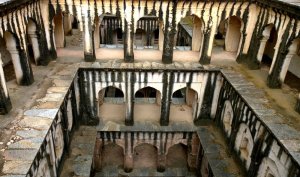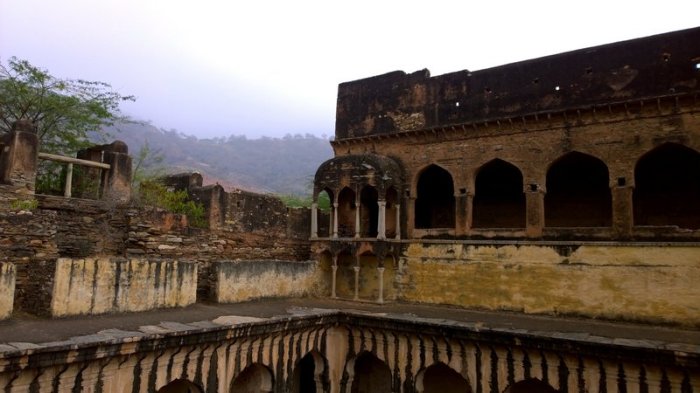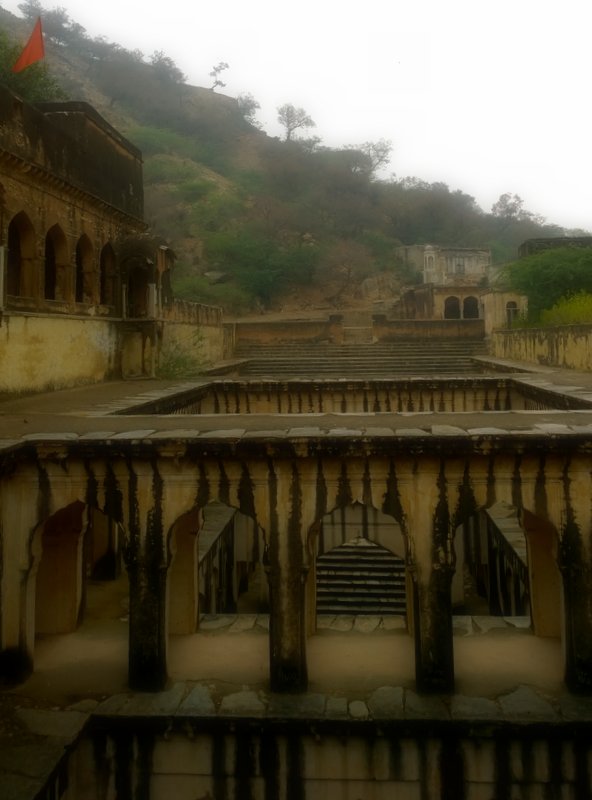One place that everyone I spoke to in Shekhawati said I must visit was Lohargal. And all gave different reasons for visiting it.
It is our hill station, said one. You get the best pickles in the world there, said another. It is a holy place and a dip in the tank will remove your sins, said the third person. There is an ancient sun temple there, said the fourth. The mention of the sun temple got me intrigued. Then another person said, “There’s a stepwell at Lohargal. If you’re interested in history, you must go there.” The stepwell was the clincher to visit Lohargal.
That’s how on my return journey to Jaipur from Nawalgarh, at the end of my Shekhawati trip, I took a detour to visit the stepwell at Lohargal. It was an hour’s drive from Nawalgarh through steady rain, narrow roads skirting the Aravali ranges, and some beautiful scenery.
When we arrived at the stepwell, which is on the road, the rain had lessened to a light drizzle.

As soon as the car stopped outside the stepwell complex, we were surrounded by the welcoming committee, a group of loud and aggressive langurs. They pounded on the windows, jumped on the roof of the car, tried to pull the wipers from the windshield — in other words I couldn’t get out of the car without the risk of being attacked. We stayed in the car for the next 10 minutes or so hoping that the langurs would go away, but they had no intention of leaving.
Just as I was wondering what to do, a local man, who was passing by, realised what the problem was. He chased the langurs away and once they had gone indicated that it was safe for me to venture out of the car. He also insisted on accompanying me to the stepwell and saw me to the car when I finished. Only then did he take his leave.
 Ranjit, that was his name, also ended up playing guide at the stepwell. Surprisingly, or maybe not, there wasn’t any information on the stepwell — it’s name, builder, age… In fact, there wasn’t anything that indicated that there was a stepwell there. If I hadn’t been looking out for the it, I could have missed it altogether.
Ranjit, that was his name, also ended up playing guide at the stepwell. Surprisingly, or maybe not, there wasn’t any information on the stepwell — it’s name, builder, age… In fact, there wasn’t anything that indicated that there was a stepwell there. If I hadn’t been looking out for the it, I could have missed it altogether.
 Locally known as Chetan Das ki Bawri or baoli, the stepwell descends seven levels below the ground. I could only see six levels, but Ranjit assured me that there was a seventh level, which was currently submerged under water. This level would be visible in summer when the water level fell. I was able to descend till the third level after which the steps were either missing or so crumbly that I decided against descending any further.
Locally known as Chetan Das ki Bawri or baoli, the stepwell descends seven levels below the ground. I could only see six levels, but Ranjit assured me that there was a seventh level, which was currently submerged under water. This level would be visible in summer when the water level fell. I was able to descend till the third level after which the steps were either missing or so crumbly that I decided against descending any further.
The steps are at one end of the structure and the well shaft at the other — kind of like the Rani ni Vav at Patan. But that’s where the similarity ends. The walls are plain with no ornamentation either in the form of sculptures or paintings. The only relief, if one can call it that, from the plain structure, are the arched galleries at every level. Years of water seeping from the ground and into the stepwell has led to the inner walls developing a striped pattern throughout.
On one side of the stepwell are the ruins of what would have been a palace, or a dharamshala or even a temple complex. Though, I wanted to see it, Ranjit advised me against it as was home to the langurs.



 I had hardly been at the stepwell for 10-15 minutes when it started raining heavily forcing me to leave. As we walked back to my car, Ranjit told me that there was a water tank at the foot of the hills behind the stepwell complex, which collected run off and helped in recharging the groundwater levels. This, in turn, helped maintain water levels in the stepwell.
I had hardly been at the stepwell for 10-15 minutes when it started raining heavily forcing me to leave. As we walked back to my car, Ranjit told me that there was a water tank at the foot of the hills behind the stepwell complex, which collected run off and helped in recharging the groundwater levels. This, in turn, helped maintain water levels in the stepwell.

I find stepwells fascinating and can’t get enough of them — their architecture, location, and most of all their stories. Chetan Das ki Bawri, too, would have a story to share; unfortunately, it needs to be found.I was indeed lucky to have Ranjit with me for I would not have come to know even the little bit of information I got on the stepwell otherwise.
In the 6 months since my return to Mumbai, I have tried to find more about Chetan Das ki Bawri. Who was Chetan Das? Did he build the stepwell? Or was it named after him? When was it built? The questions are endless and the answers elusive.
Dear reader, if you know anything about this stepwell, please do share it with me. And if you wish to visit this stepwell, you know what to do ! 🙂
Follow me on Twitter, Facebook and Instagram as I explore the world around me.
The Painted Towns of Shekhawati Series: Introduction | Nawalgarh | Dundlod | Mandawa | Lakshmangarh | Fatehpur | Bissau | Mahensar
Other Shekhawati-related posts: The Shekhawati trip planner | The painter of murals | Messages on the wall: The graffiti of Nawalgarh | The stepwell at Lohargal | The garbage well |

The first photo is – Wow.
LikeLike
Thanks, Tushar. The first photo is exactly as I saw the stepwell in its entirety for the first time — the steps leading down (which I cropped for a sqaure picture. Instagram, you know), the well and well shaft at the other end and the Aravalli mountain ranges beyond that. Beautiful sight, isn’t it?
LikeLike
i too am quite fascinated by the architecture and concept of stepwells. i read somewhere that the British were not very keen on letting locals use the baolis because they thought stagnant water was unhealthy and hence the use of stepwells was discouraged to make way for canals in India. Had the local knowledge not been suppressed, there might have been more functioning and well preserved baolis.
LikeLike
I haven’t come across that piece of information, Shoma. Thank you for sharing it.
I don’t think local knowledge has gone away; we just don’t value it anymore. If if we don’t value it we won’t take care of it. Which is why we have buildings unsuitable for the terrain we live in build of materials even more unsuitable. Just think of buildings with glass facades in a tropical country that receives so much sunlight and you’ll know what I mean.
We have the means to understand ancient technology and use it and yet we prefer to adopt something totally unsuitable for us. 😦
LikeLike
One more reason for me to return to Shekhawati region!!!! Thanks for sharing the details and pictures.
LikeLike
I didn’t know you needed reasons to return to Shekhawati 🙂 😉
LikeLiked by 1 person
Thanks for this fascinating share…. Such advanced architecture in those days…..
Natureram
LikeLiked by 1 person
You’re welcome, Depibam. Our ancestors were far smarter and more advanced in spite of lack of technology as we know it today. Our built heritage is testimony to this.
LikeLike
Glad to know about this place. Nice post.
LikeLike
Thanks, Niranjan. I hope that you get to visit it one day. 🙂
LikeLike
Your blog is a goldmine for a history nut like me! I always read it when I am in need of a break at office and almost always come away refreshed! I hope you’ll find out the story of Chetan Das and update it here 🙂
LikeLiked by 1 person
Thank you for such wonderful words of appreciation, Divya. They made my day 🙂
LikeLike
Oh dear! Now I have to somehow slip in Lohargal to our August ity; or go back to Shekawati at some point later in the year. But this I’d definitely like to see for myself. Btw, no one I have spoken with thus far , the people based in Shekawati region, knows of Lohargal! Thank you for finding it for us.
LikeLiked by 1 person
Oh dear, dear. 😛
Lohargal is not too far from Nawalgarh and you could combine a visit to the stepwell with a visit to the ancient Sun Temple then and some pickle shopping. Lohargal is full of mango trees and the mangoes grown here are known for their pickling quality. The road leading to the Sun Temple is lined, not with flower shops or those selling poojs items, but shops selling pickles. It was an experience, I must say.
People in Shekhawati do know of Lohargal, but since it does not have any painted havelis they probably think that it may not interest the tourists. The Sun Temple there is supposed to be an ancient one, and even on that rainy January day, when my teeth were chattering in the cold, people were trekking to the temple to take a dip in the tank.
Now, how you adjust this into your itinerary is your headache 😛
LikeLike
That first pic of the stepwell took my breath away!
And I’m not even a history or an architecture nut!!
LikeLike
The setting is gorgeous, Shekhar. Even better that what the photograph shows. And you don’t have to be a history or architecture not to appreciate it 🙂
LikeLiked by 1 person
Hi Sudhagee,
Your description of the journey to this place is very interesting. I felt like I was living your experiences through your writing. I will certainly visit this place and go the step well you have mentioned. It is very intriguing to read about Chetan Das and the mystery behind the step well.
LikeLike
A very warm welcome here, Anoop. Thank you so much for stopping by and commenting.Stepwells fascinate me and I am yet to visit one that did not interest me. Looks like you are a stepwell enthusiast too. You will enjoy visiting Chetan Das ki Bawdi. 🙂
LikeLike
Sudhaji 🙂 namaskar, sat shri Akal !! got a comprehensive idea about lohargal. and of course baoli. I chase baolis 😀 and do by driving around the country but lohargal was still missing.
thanks to you for his fabulous post. I driving in march from Mumbai o see he 7h level what ou missed
LikeLike